SSRN-id4496137.pdf (dailysceptic.org)
Your Coronavirus Test Is Positive. Maybe It Shouldn’t Be.
The usual diagnostic tests may simply be too sensitive and too slow to contain the spread of the virus.

Some of the nation’s leading public health experts are raising a new concern in the endless debate over coronavirus testing in the United States: The standard tests are diagnosing huge numbers of people who may be carrying relatively insignificant amounts of the virus.
Most of these people are not likely to be contagious, and identifying them may contribute to bottlenecks that prevent those who are contagious from being found in time. But researchers say the solution is not to test less, or to skip testing people without symptoms, as recently suggested by the Centers for Disease Control and Prevention.
Instead, new data underscore the need for more widespread use of rapid tests, even if they are less sensitive.
“The decision not to test asymptomatic people is just really backward,” said Dr. Michael Mina, an epidemiologist at the Harvard T.H. Chan School of Public Health, referring to the C.D.C. recommendation.
“In fact, we should be ramping up testing of all different people,” he said, “but we have to do it through whole different mechanisms.”
In what may be a step in this direction, the Trump administration announced on Thursday that it would purchase 150 million rapid tests.
The most widely used diagnostic test for the new coronavirus, called a PCR test, provides a simple yes-no answer to the question of whether a patient is infected.
But similar PCR tests for other viruses do offer some sense of how contagious an infected patient may be: The results may include a rough estimate of the amount of virus in the patient’s body.
“We’ve been using one type of data for everything, and that is just plus or minus — that’s all,” Dr. Mina said. “We’re using that for clinical diagnostics, for public health, for policy decision-making.”
But yes-no isn’t good enough, he added. It’s the amount of virus that should dictate the infected patient’s next steps. “It’s really irresponsible, I think, to forgo the recognition that this is a quantitative issue,” Dr. Mina said.
The PCR test amplifies genetic matter from the virus in cycles; the fewer cycles required, the greater the amount of virus, or viral load, in the sample. The greater the viral load, the more likely the patient is to be contagious.
This number of amplification cycles needed to find the virus, called the cycle threshold, is never included in the results sent to doctors and coronavirus patients, although it could tell them how infectious the patients are.
In three sets of testing data that include cycle thresholds, compiled by officials in Massachusetts, New York and Nevada, up to 90 percent of people testing positive carried barely any virus, a review by The Times found.
On Thursday, the United States recorded 45,604 new coronavirus cases, according to a database maintained by The Times. If the rates of contagiousness in Massachusetts and New York were to apply nationwide, then perhaps only 4,500 of those people may actually need to isolate and submit to contact tracing.
One solution would be to adjust the cycle threshold used now to decide that a patient is infected. Most tests set the limit at 40, a few at 37. This means that you are positive for the coronavirus if the test process required up to 40 cycles, or 37, to detect the virus.
Tests with thresholds so high may detect not just live virus but also genetic fragments, leftovers from infection that pose no particular risk — akin to finding a hair in a room long after a person has left, Dr. Mina said.
Any test with a cycle threshold above 35 is too sensitive, agreed Juliet Morrison, a virologist at the University of California, Riverside. “I’m shocked that people would think that 40 could represent a positive,” she said.
A more reasonable cutoff would be 30 to 35, she added. Dr. Mina said he would set the figure at 30, or even less. Those changes would mean the amount of genetic material in a patient’s sample would have to be 100-fold to 1,000-fold that of the current standard for the test to return a positive result — at least, one worth acting on.

The Food and Drug Administration said in an emailed statement that it does not specify the cycle threshold ranges used to determine who is positive, and that “commercial manufacturers and laboratories set their own.”
The Centers for Disease Control and Prevention said it is examining the use of cycle threshold measures “for policy decisions.” The agency said it would need to collaborate with the F.D.A. and with device manufacturers to ensure the measures “can be used properly and with assurance that we know what they mean.”
The C.D.C.’s own calculations suggest that it is extremely difficult to detect any live virus in a sample above a threshold of 33 cycles. Officials at some state labs said the C.D.C. had not asked them to note threshold values or to share them with contact-tracing organizations.
For example, North Carolina’s state lab uses the Thermo Fisher coronavirus test, which automatically classifies results based on a cutoff of 37 cycles. A spokeswoman for the lab said testers did not have access to the precise numbers.
This amounts to an enormous missed opportunity to learn more about the disease, some experts said.
“It’s just kind of mind-blowing to me that people are not recording the C.T. values from all these tests — that they’re just returning a positive or a negative,” said Angela Rasmussen, a virologist at Columbia University in New York.
“It would be useful information to know if somebody’s positive, whether they have a high viral load or a low viral load,” she added.
Words to Know About Testing
Confused by the terms about coronavirus testing? Let us help:
-
- Antibody: A protein produced by the immune system that can recognize and attach precisely to specific kinds of viruses, bacteria, or other invaders.
- Antibody test/serology test: A test that detects antibodies specific to the coronavirus. Antibodies begin to appear in the blood about a week after the coronavirus has infected the body. Because antibodies take so long to develop, an antibody test can’t reliably diagnose an ongoing infection. But it can identify people who have been exposed to the coronavirus in the past.
- Antigen test: This test detects bits of coronavirus proteins called antigens. Antigen tests are fast, taking as little as five minutes, but are less accurate than tests that detect genetic material from the virus.
- Coronavirus: Any virus that belongs to the Orthocoronavirinae family of viruses. The coronavirus that causes Covid-19 is known as SARS-CoV-2.
- Covid-19: The disease caused by the new coronavirus. The name is short for coronavirus disease 2019.
- Isolation and quarantine: Isolation is the separation of people who know they are sick with a contagious disease from those who are not sick. Quarantine refers to restricting the movement of people who have been exposed to a virus.
- Nasopharyngeal swab: A long, flexible stick, tipped with a soft swab, that is inserted deep into the nose to get samples from the space where the nasal cavity meets the throat. Samples for coronavirus tests can also be collected with swabs that do not go as deep into the nose — sometimes called nasal swabs — or oral or throat swabs.
- Polymerase Chain Reaction (PCR): Scientists use PCR to make millions of copies of genetic material in a sample. Tests that use PCR enable researchers to detect the coronavirus even when it is scarce.
- Viral load: The amount of virus in a person’s body. In people infected by the coronavirus, the viral load may peak before they start to show symptoms, if symptoms appear at all.
Officials at the Wadsworth Center, New York’s state lab, have access to C.T. values from tests they have processed, and analyzed their numbers at The Times’s request. In July, the lab identified 872 positive tests, based on a threshold of 40 cycles.
With a cutoff of 35, about 43 percent of those tests would no longer qualify as positive. About 63 percent would no longer be judged positive if the cycles were limited to 30.
In Massachusetts, from 85 to 90 percent of people who tested positive in July with a cycle threshold of 40 would have been deemed negative if the threshold were 30 cycles, Dr. Mina said. “I would say that none of those people should be contact-traced, not one,” he said.
Other experts informed of these numbers were stunned.
“I’m really shocked that it could be that high — the proportion of people with high C.T. value results,” said Dr. Ashish Jha, director of the Harvard Global Health Institute. “Boy, does it really change the way we need to be thinking about testing.”
Dr. Jha said he had thought of the PCR test as a problem because it cannot scale to the volume, frequency or speed of tests needed. “But what I am realizing is that a really substantial part of the problem is that we’re not even testing the people who we need to be testing,” he said.
The number of people with positive results who aren’t infectious is particularly concerning, said Scott Becker, executive director of the Association of Public Health Laboratories. “That worries me a lot, just because it’s so high,” he said, adding that the organization intended to meet with Dr. Mina to discuss the issue.
The F.D.A. noted that people may have a low viral load when they are newly infected. A test with less sensitivity would miss these infections.
But that problem is easily solved, Dr. Mina said: “Test them again, six hours later or 15 hours later or whatever,” he said. A rapid test would find these patients quickly, even if it were less sensitive, because their viral loads would quickly rise.
PCR tests still have a role, he and other experts said. For example, their sensitivity is an asset when identifying newly infected people to enroll in clinical trials of drugs.
But with 20 percent or more of people testing positive for the virus in some parts of the country, Dr. Mina and other researchers are questioning the use of PCR tests as a frontline diagnostic tool.
People infected with the virus are most infectious from a day or two before symptoms appear till about five days after. But at the current testing rates, “you’re not going to be doing it frequently enough to have any chance of really capturing somebody in that window,” Dr. Mina added.
Highly sensitive PCR tests seemed like the best option for tracking the coronavirus at the start of the pandemic. But for the outbreaks raging now, he said, what’s needed are coronavirus tests that are fast, cheap and abundant enough to frequently test everyone who needs it — even if the tests are less sensitive.
“It might not catch every last one of the transmitting people, but it sure will catch the most transmissible people, including the superspreaders,” Dr. Mina said. “That alone would drive epidemics practically to zero.”
Correction:
An earlier version of this article, using information provided by a laboratory spokesman, misstated the number of positive coronavirus tests in July processed by Wadsworth Center, New York's state lab. It was 872 tests, not 794. Based on that error, the article also misstated the number of tests that would no longer qualify as positive with a C.T. value of 35 cycles. It is about 43 percent of the tests, not about half of them. Similarly, the article misstated the number of tests that would no longer qualify as positive if cycles were limited to 30. It is about 63 percent of the tests, not about 70 percent.
Apoorva Mandavilli is a reporter focusing on science and global health. She is the 2019 winner of the Victor Cohn Prize for Excellence in Medical Science Reporting. @apoorva_nyc
COVID-19: Diagnostic Accuracy of Current Serological Tests Not Good Enough
Priscilla Lynch
July 09, 2020
Current evidence does not support continued use of existing point-of-care serological tests for COVID-19, concludes a new systematic review and meta-analysis in the BMJ.
Researchers searched Medline, bioRxiv and medRxiv from 1 January 2020 to 30 April 2020 for studies related to COVID-19 and serological tests.
Eligible studies measured sensitivity, specificity or both of a COVID-19 serological test compared with a reference standard of viral culture or reverse transcriptase polymerase chain reaction. Risk of bias was assessed using quality assessment of diagnostic accuracy studies 2 (QUADAS-2). Pooled sensitivity and specificity were estimated using random effects bivariate meta-analyses.
A total of 5014 references were identified, and 40 studies were included.
High risk of patient selection bias was found in 98 per cent (48/49) of assessments and high or unclear risk of bias from performance or interpretation of the serological test in 73 per cent (36/49). Only 10 per cent (4/40) of studies included outpatients. Only two studies evaluated tests at the point of care.
For each method of testing, pooled sensitivity and specificity were not associated with the immunoglobulin class measured. The pooled sensitivity of enzyme linked immunosorbent assays (ELISAs) measuring immunoglobulin G or immunoglobulin M was 84.3 per cent (95% CI, 75.6%-90.9%), of lateral flow immunoassays (LFIAs) was 66.0 per cent (95% CI, 49.3%-79.3%) and of chemiluminescent immunoassays (CLIAs) was 97.8 per cent (95% CI, 46.2%-100%).
In all analyses, pooled sensitivity was lower for LFIAs, the potential point-of-care method. Pooled specificities ranged from 96.6 per cent to 99.7 per cent. Of the samples used for estimating specificity, 83 per cent (10,465/12,547) were from populations tested before the epidemic or not suspected of having COVID-19. Among LFIAs, pooled sensitivity of commercial kits (65.0%; 95% CI, 49.0%-78.2%) was lower than non-commercial tests (88.2%; 95% CI, 83.6%-91.3%).
Heterogeneity was seen in all analyses. Sensitivity was higher for at least three weeks after symptom onset (range, 69.9%-98.9%) compared with within the first week (from 13.4% to 50.3%).
Higher-quality clinical studies assessing the diagnostic accuracy of COVID-19 serological tests are urgently needed, the researchers said.
Lisboa Bastos M, Tavaziva G, Abidi SK, Campbell JR, Haraoui LP, Johnston JC, Lan Z, Law S, MacLean E, Trajman A, Menzies D, Benedetti A, Ahmad Khan F. Diagnostic accuracy of serological tests for covid-19: systematic review and meta-analysis. BMJ. 2020;370:m2516. doi: 10.1136/bmj.m2516. PMID: 32611558. Full text.
This article originally appeared on Univadis, part of the Medscape Professional Network.
PROFESSOR KAROL SIKORA SAYS TESTING IS COBBLED TOGETHER
This transcript has been edited for clarity. July 18th 2020
Hi there, it's Professor Karol Sikora here. I'm an oncologist and I'm talking about measurement in the era of coronavirus.
You know, in cancer, we're absolutely assiduous about what we do with measurements. We take X-rays, images, tumour markers, blood tests, to try and assess how far a tumour has spread and how it's doing. We then give an intervention, chemotherapy, radiotherapy, and we do the same measurements again. We understand the value of getting precise metrics to follow what's happening with cancer.
I'm not an infectious disease physician, but I can see the benefits of measurement in corona. And to be honest, we've done it very badly in the UK, or at least public health services have not been on top of the measurement of this pandemic. It's been cobbled together by a government that doesn't really understand the science behind it all.
MEASURING A PANDEMIC
If we begin with that. What measurements can we make to sort things out in a pandemic?
Number 1 is the incidence of infection.
Number 2 is the number of hospitalisations. That's fairly simple. You just count the number of people coming into hospital. Some of them probably are not going in because they have corona and sorting that out is somewhat difficult.
Intensive care admissions for breathing difficulties is another one.
DEATH RATE
The death rate, that's not so easy. Some of the deaths are definitely due to corona, others are definitely not to corona, yet some of those may have corona on a PCR test. So what do you count those patients as? And then there's ones in the middle where you just don't know if they had corona and died from it, or it just happens that they've died with corona, and died of cancer or a myocardial infarction or whatever.
RECOVERY FIGURES
And then finally, you've got recovery figures, which Britain has never published. All other countries, the majority of other countries, publish them regularly. We haven't done so for a variety of complex reasons.
KEY METRICS
So, what's the key metric in all this? Well, the two key metrics are incidence and death. Incidence is perhaps more useful, because it tells you how we're going. There’s a huge lag in the deaths, especially now the main bulk of patients that have been infected have been so. So we're looking at people that have had complicated diseases, multi-system failure, renal failure, liver problems, cardiac failure, coming through the system and coming to the end, and then sadly dying.
What we're seeing now is a tail of the death curve.
INCIDENCE
But let's take the incidence because that's the key to second wave and all the other doom scenarios that could happen.
So if we look at the incidence figures, the first thing we would expect if there's a spike is for symptoms to arise. And the key symptoms we all know, shortness of breath, a dry cough, fever, and anosmia, lack of smell [and taste].
If you look at this very well curated data by NHS Digital from 111 and 999 telephony around the country, all collected every day and graphically displayed, you can see that at the peak of the pandemic, it was massive. Everybody was phoning up, getting through, or online inquiries getting through, and now it's gone right down.
Nothing happened after the demos in London and big cities. Nothing happened after the beaches were crowded with people in the first wave of the heatwave in the spring this year, and they haven't happened after the pubs opened 10 days ago.
I remember having a beer on Saturday lunchtime, looking around thinking this is, this is going to cause a bit of a blip, but it hasn't. It's now day 10, you'd expect to see a rise and there hasn't been which is really gratifying.
And in all fairness, there wasn't in Austria or the Czech Republic that came out of this 3 months ago. So this seems like good news.
TESTING
So the second thing is the testing. PCR testing is all there is. Forget the antibody, that doesn't tell you information about incidence it just tells you the prevalence of immune function against the virus.
So let's look at the PCR testing. Very confusingly. There's two pillars. Pillar 1 was run by Public Health England using hospital labs for staff in hospitals. Pillar 2 was commercially outsourced to big companies such as Randox, to set up testing stations - sometimes helped by the military to run the stations - and these were very effective at picking up cases.
The problem is, is how the data were handled. And in a report out on Sky News, which is really worth the read, 'Coronavirus, the inside story of how UK’s chaotic testing regimen broke all the rules'.
It's a fascinating read. It shows that things were just made up on bits of paper to give something for ministers to say at these dreadful 5 o'clock briefings, that if you could bear to watch, if you’d got nothing better to do, were just awful.
So, I think you know, both the pillar 1 and pillar 2 have shown that now we're right down. We're less than 600 cases consistently. And hopefully we'll drop to 200 or 300 cases and it'll gradually disappear as August goes through.
TEST AND TRACE
The real problem though, is the test and trace programme. You know, it's just not working. And despite the 'world class' scenario with or without the app tested on the Isle of Wight, shown to be completely useless, the whole system is just not working.
And the reason probably it's not working is that there's no trust in it. If I get phoned up by a contact tracer to say that yesterday I was in a bar and I had a drink, and someone within a metre of me has been tested as positive, and I should go and isolate for 14 days - would I do that?
Who was it? Who will give me the name? Let me make the assessment how close I was, because just because I was in the same room as someone doesn't mean I'm likely to be infected by them.
So it's a very difficult area for measurement and for making it sensible.
A MANAGER WITHOUT RELEVANT EXPERIENCE
The good Baroness Dido Harding, Oxford and Harvard educated business lady, former chief executive of TalkTalk, the phone company, she was given the job. I didn't see it advertised in the BMJ.
What one wonders is, why is someone like that able to run a very ambitious programme with no previous experience of infection control or managing expectations?
Surely there should be someone in Public Health England that could run that sort of programme very effectively.
So, as we come out of this what we're going to see are little blips, Leicester [back in lockdown], a Herefordshire Farm, these sort of things will come.
TRANSPARENCY
It's really important that we have transparency in the data. At the moment it's all kept hidden. The council in Hereford made a noise about it wasn't given the data, Leicester council gave the same feeling, they weren't given the NHS Public Health England data or the commercial testing data.
Complete transparency, with anonymity, of course, for the individuals involved, is absolutely vital if we're going to get this to work.
OTHER COUNTRIES
Other countries have done so much better. If we look at Singapore, Seoul in Korea, these are models of how to do it.
In Seoul, a guy goes into the nightclub district on a Saturday night heavily infected, and 700 people get infected. That was 2 months ago nearly. All sorted within 3 or 4 weeks, all gone. Everybody isolated, tested and moving on. Not a single case in that district anymore after quite a sizable outbreak because the chap went to serial bars and danced through the night singing and yelling and had a few drinks too many I suspect.
GETTING OUR ACT TOGETHER
We've got to get our act together much better here. It's back to where I started. In oncology, we measure everything and we do it very well. And that's the secret of success in cancer medicine.
In this, the secret of success is measuring an infection rate, we need to do that. Otherwise, it could be that the doomsayers of more second waves, third waves, that more incidence and deaths, could be correct. Let's not have that. Let's measure correctly now and do it properly.
Karol Sikora. Thank you for listening.











